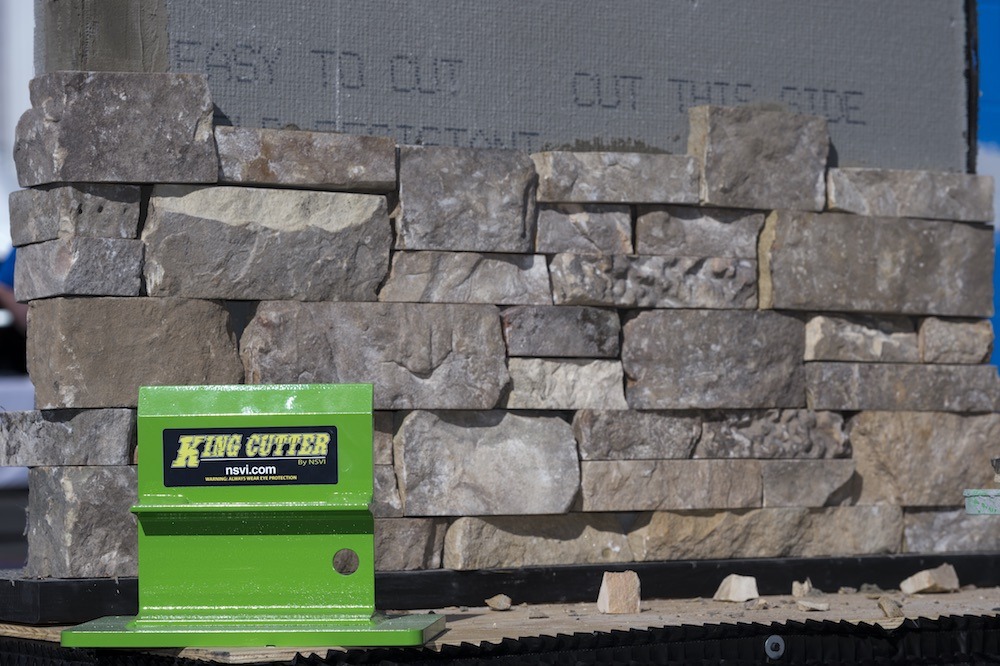You’re renovating a fireplace in the living room of an expensive house. The crew doesn’t want to make a mess so they climb up and down scaffolding, going outside to make the messy cuts then back in with their newly cut stone.
Now imagine this crew with a new stone trim tool called the King Cutter. This thing helps eliminate some— no, a lot— of those steps of cutting and trimming natural thin veneer. It’s hard not to notice how much quicker this project is going because of that lime green doodad that really leaves a natural edge to the cut stone. That solid steel tool works faster than some saws or other cutting devices. Plus it’s lightweight. Crews can place it directly on scaffolding or workstations and trim stone right there inside the house.
The King cutter, an aptly named stationary chisel, can be used for manufactured stones, thin bricks, even some flagstone for landscaping purposes. Its space-saving shape features a built-in handle, and it doesn’t require a power source. It prevents masons from having to use four-inch grinders, which stir up a cloud of dust and a mess. Some benefits include reduced noise and dust. And of course, by minimizing dust, the King Cutter helps crews adhere to Silica Dust laws on their projects.
“It’s a simple tool that works,” says Brett King, who helped develop the tool for Natural Stone Veneers International. You might recognize his name from his appearances talking about natural stone veneer installation on “The Old House.” Here, he explains the tool’s humble beginnings.
“The sample guy at our office was trimming over a dump tub,” he says. Soon enough a couple of people were watching. They could see a better way was possible and after a while they had an idea of how to find it. “We welded up some metal and worked out the King Cutter’s design. We wanted it to cut well but we also had to decrease some of the shock. Now it sends all its energy right through the stone and makes a nice clean cut.”
It’s imperative to remember the King Cutter is predominantly used for thin stone. It works, for example, on manufactured thin veneer and flagstone. Stone thicker than two inches, however, becomes more difficult to cut. It works best on softer stones and anything between three quarters of an inch and two inches. For sandstone or material that isn’t variegated, the tool will break in the desired place you want it, King says. Sometimes, with material that has variegations, the split is slightly less controllable.
But variegated or not, masons have found the King Cutter useful on many different projects. Consider one Madison, WI. project that involved about 35,000 ft. of stone.
“I gave one of the King Cutters to the mason contractor, who had about four or five crews on the project. The very next day he ordered five more units because the cutters worked so well,” King says. “He had access to other tools on the scaffold with it, but this was the one tool that was quick and fast to use. If the crews had to do intricate cuts, they’d still use a saw. But for laying the material with a natural edge, the King Cutter was perfect.”
Here’s how it works:
Secure the King Cutter with two screws onto the flat surface you’re cutting stones on. A lanyard gives an additional layer of safety when attached to scaffolding.
Hold a thin veneer stone over the King Cutter’s edge. With a brick hammer, create a score line on the flat side of the stone. Hammer the line once or twice. As easy as that, the stone now bears a clean cut and is ready for buttering.
See the demonstration here. https://www.youtube.com/watch?v=0pL9PulDYjI
Learn more about the King Cutter at www.NSVI.com.

